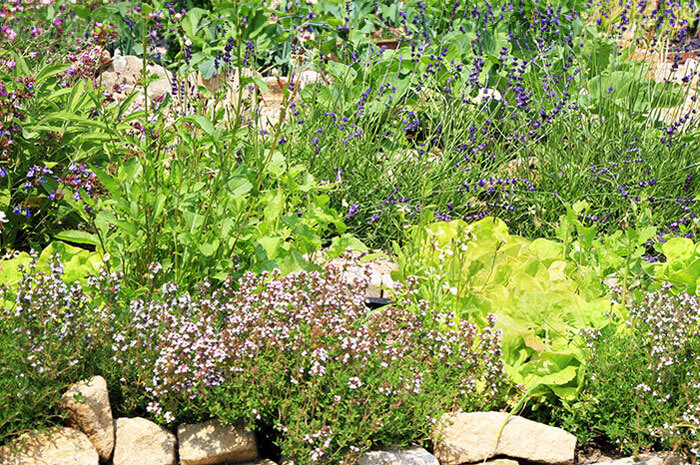
There’s nothing wrong with having an enviable, lush green lawn. The practice of turfing your yard has been around since the 18th century when landscape designers in England and France began cutting grass areas short in gardens (although this was done through the use of grazing animals or by hand-cutting the grass) and is now common practice. However, there is one catch to manicured lawns: they aren’t always friendly to pollinators like bees and butterflies.
Recent concerns about bee and butterfly populations have prompted people to start looking for ways to attract pollinators and other beneficial insects to their yards, improving populations and adding intrigue to the typical rows of green grass on their block. If you’re interested in joining the movement, consider reimagining your lawn to be pollinator friendly or creating a designated pollinator garden somewhere on your property. With the right knowledge, pollinator lawns and gardens are easy to develop and maintain.
What is a Pollinator Lawn or Garden?
A pollinator lawn is a yard that features a natural look and feel, with sprawling native flowers instead of abundant low-cut grass. Pollinator lawns generally require less fertilizer and pesticide than grass lawns, as the soil is usually already prime for local flora. For families looking for a low-input, insect-friendly yard, a pollinator lawn may be ideal.
A pollinator garden also features a bounty of native flowers, but instead of encompassing all or several parts of your lawn, it’s contained to just one area. Pollinator gardens make a great solution for those wanting to attract pollinators and beneficial insects without completely altering their yards — which can be important when complying with city or HOA regulations.
Both pollinator lawns and gardens are great at providing food to insects — such as bees and butterflies — that help pollinate other plants.
How Do You Create a Pollinator Lawn or Garden?
To start, it’s ideal to plant native seed during the fall.
Pollinator lawns and pollinator gardens are specific to the insects that are located in your region, so it’s important to understand what flowering plants are native. While non-native plants may be beautiful or desirable, they may not act as food for your local insects — which ruins the whole point of pollinator lawns and gardens. A local greenhouse or plant store can help you determine the right flowers that will attract pollinators and beneficial insects.
Once you’ve determined what plants are native to your location, determine whether you want to include flowering plants within the existing turf or remove the turf entirely. This often depends on whether you’d like to create an entire pollinator lawn or a designated pollinator garden.
If you want to include native flowers into your existing turf, aerate the soil to reduce compaction. This will help water and oxygen reach the seeds, while ensuring that the soil isn’t too dense for sprouts to break through. After aeration, spread your native plant seed over the top of the grass wherever you’d like flowers to pop up, being mindful of different sun conditions in your yard.
To replace your turf entirely, first pull up your existing lawn manually with a flat shovel, or by using a motorized sod cutter or rototiller. Once this is complete, mix grass and native plant seed in a lawn spreader — according to your preferred lawn-to-plant ratio — and spread your seed mixture. Next, use an organic topdressing of compost or straw to protect your seeds while they germinate.
Whether you’re seeding over your turf or replacing your entire lawn, you’ll want to lightly water your seeded areas until you see them sprout. The roots will continue to establish themselves throughout the winter, and you’ll see seedlings start to develop in the spring.
How Do You Maintain a Pollinator Lawn or Garden?
As mentioned previously, pollinator lawns and pollinator gardens are easy to maintain.
While frequent watering is needed while your pollinator lawn or garden gets established (during seeding and the first year), it shouldn’t require additional watering unless your region is dealing with prolonged drought.
Similarly, if you’re growing a pollinator lawn, you’ll want to mow less often than traditional grass. Because flowers grow at the end of stalks, you should mow every 2-3 weeks during peak growing season at a mowing height of 5 inches or higher. This will allow for flowers to bloom, attracting pollinators and beneficial insects.
Pollinator gardens are even easier to manage, assuming you don’t feel the need to mow them. Since they’re made of native plants that are meant to grow freely, pollinator gardens require minimal maintenance.
What if I Can’t Replace Much of My Lawn?
Most people are unable or unwilling to replace their entire lawn, and that’s okay. Anything you can do to help is beneficial. If local regulations don’t allow for you to have a pollinator friendly lawn — or if you just don’t want to sacrifice your beautiful, manicured lawn — explore creating a pollinator garden instead. Pollinator gardens can be as big or small as you want them to be.
You can also plant native flowers in pots, planter boxes or in your existing landscaping. A few plants here and there should be enough extra flora to help your local bees and butterflies. But again, you will want to discuss native pollinator flowers with your local greenhouse or plant store to determine which will work best for attracting beneficial insects.
It’s also important to note that vegetable gardens, flowering trees and flowering shrubs can help your local pollinators, too.
Are You Ready for a Pollinator Lawn or Garden?
While there certainly is something beautiful about a perfectly manicured lawn, creating a natural pollinator friendly lawn or pollinator garden is often a more environmentally friendly choice — and sometimes just as attractive. Pollinator lawns and gardens are a great way of not only helping out the insects and local vegetation, but getting your family to appreciate nature. And, don’t forget, less yard work (in theory).



